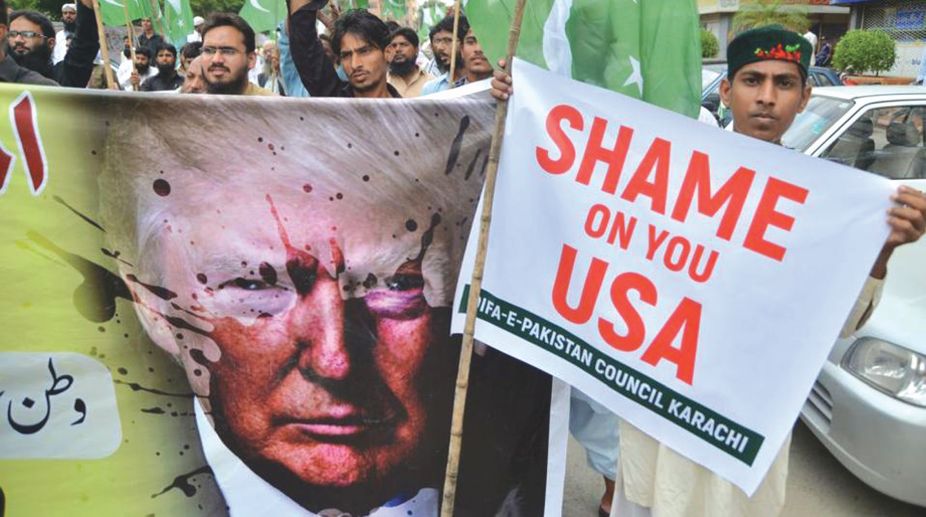President Donald Trump’s New Year tweet has sent the Pakistan-US relationship into a tailspin. Incidentally, the decision to cut assistance to Pakistan had been in the works for some time. In fact, when this US administration came into office, there was chatter about “giving Pakistan a year” to see if things changed for the better. The year is just about up.
Last week’s decision isn’t a one-off. What we’ve witnessed is an initiation of a brinkmanship exercise — the firing of an opening salvo that declares intent to impose pain on Pakistan to get it to deliver on America’s principal ask: action against the Afghan Taliban and Haqqani network.
Advertisement
Brinkmanship is a battle of nerves in which both sides believe they have more resolve to stay the course than the opponent. Failure to get the opposite number to cave in adds to the pressure to try harder in the next move. Neither actor necessarily wants a total breakdown, but in the process of out-nerving the other, either can make a miscalculation.
The pressure to climb the escalation ladder was built into the US’s first move as it was sure to draw a blank. Even proponents of last week’s decision in Washington who argue that Pakistan can be moulded by leveraging US assistance agree that withdrawing security aid and the Coalition Support Funds was going to do little to deliver any strategic gains for the US. The fiscal year 2017’s appropriated amount of US security assistance to Pakistan was around $300 million. Actual disbursements are often lower. CSF authorisation was around $1 billion annually for fiscal years 2015-17, but between a third and a half of it was already conditioned on Pakistan’s anti-terrorism performance and withheld.
If you want to get really technical, you’d also have to factor in money from prior fiscal years that is still in the pipeline. This would push the overall amount up by another $300-400m, although not all of this would have made it even in normal circumstances. All considered, the best estimate for the amount affected by the US decision is somewhere in the $500-900m range.
These sums are not trivial. But merely their loss is not going to bring the Pakistan Army to a standstill, or pinch the national exchequer seriously if the army wants civilians to offset the losses from other budget heads. Pakistan’s response has signalled as much. Overall, the take has been measured. But the Inter Services Public Relations has also stood its ground on the strategic disconnect with the US.
The list of further actions the US can take against Pakistan includes increased economic pressure through multilateral forums or trade restrictions, sanctions and diplomatic isolation, even unilateral use of force. All entail risks high enough for previous US administrations to not pursue them. This may have changed.
Mr Trump has consistently shown a propensity to break the trend lines of his predecessors. Also, champions of the Pakistan-US relationship in Washington are gone. Last week’s decision is evidence of what this may mean in practical terms. Using assistance as negative leverage has been debated ad nauseam in Washington but US government deliberations on this and the larger Pakistan question have tended to be split between the hardliners and soft-liners who advocated a carrots-first approach. These voices were crucial to preventing a break in ties in tense moments. This category draws a blank now, at least in offices that really matter.
Instead, those who matter most have a clear preference on how to approach Pakistan; their take isn’t business as usual — not altogether surprising, given that unlike the Obama policy that actively sought Pakistan’s support to bring the Afghan Taliban to the table, the Trump strategy is seeking to cut the Taliban to size on the battlefield before talking. Pakistan isn’t a sideshow in their calculus. Rather, there is a consensus in Washington that Pakistan is a key impediment in the US’s ability to make solid military gains.
It is also pertinent to note that officials calling the shots have more space than usual to implement their vision because decision-making is currently not as evenly dispersed and the policymaking process is not as consensual across the various US government agencies as it typically is.
As the opponent in this brinkmanship, Pakistan will feel increasing pressure to respond stubbornly to every US move. A senior Pakistani policymaker crystallised the problem thus: “How long before the other side sees my restraint as weakness and pounces hard. I must retaliate sooner rather than later”. In an election year, these words are likely to strike a chord with most who make decisions for the country.
As brinkmanship plays out, the possibility of a serious Pakistan-US discussion on finding a way forward on Afghanistan will dwindle further. There is more trouble ahead.











